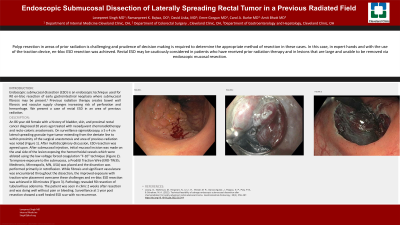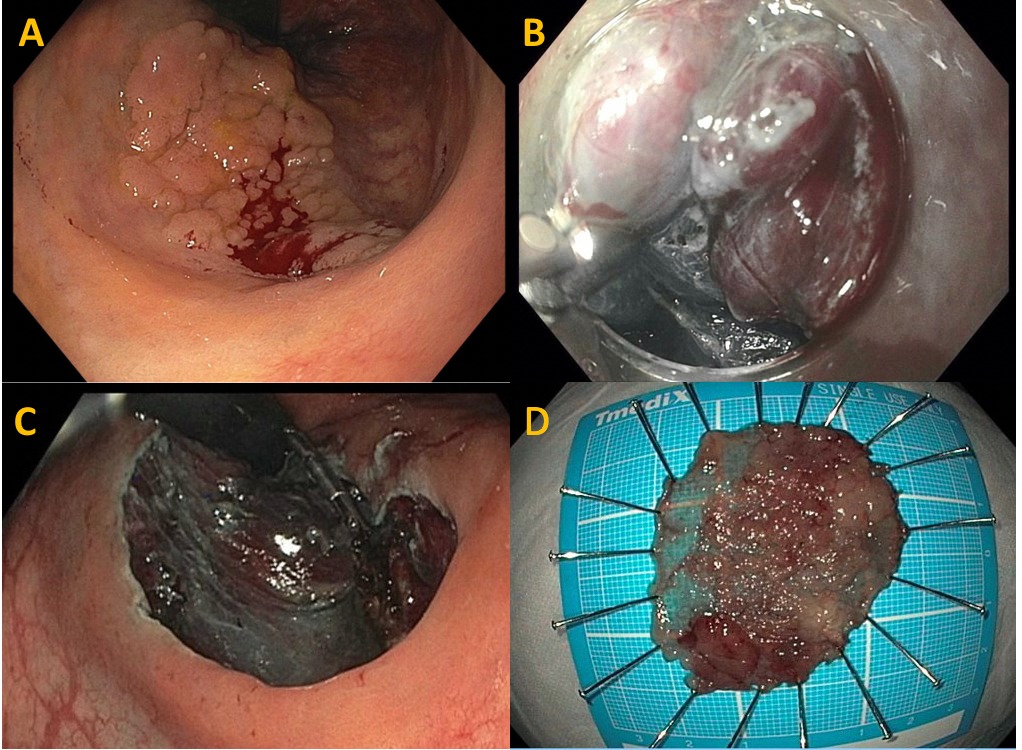Sunday Poster Session
Category: Colon
P0266 - Endoscopic Submucosal Dissection of Laterally Spreading Rectal Tumor in a Previous Radiated Field
Sunday, October 22, 2023
3:30 PM - 7:00 PM PT
Location: Exhibit Hall

Has Audio
- LS
Lovepreet Singh, MD
Cleveland Clinic Foundation
Cleveland, OH
Presenting Author(s)
Lovepreet Singh, MD1, Ramanpreet Bajwa, DO2, David Liska, MD1, Emre Gorgun, MD1, Carol A. Burke, MD, FACG1, Amit Bhatt, MD3
1Cleveland Clinic Foundation, Cleveland, OH; 2Cleveland Clinic Foundation, Shaker Heights, OH; 3Cleveland Clinic, Cleveland, OH
Introduction: Endoscopic submucosal dissection (ESD) is an endoscopic technique used for R0 en-bloc resection of early gastrointestinal neoplasia where submucosal fibrosis may be present. Previous radiation therapy creates bowel wall fibrosis and vascular supply changes increasing risk of perforation and hemorrhage. We present a case of rectal ESD in an area of previous radiation.
Case Description/Methods: Our case involves an 86 year old female with a history of bladder, skin, and proximal rectal cancer diagnosed 20 years ago treated with neoadjuvant chemoradiotherapy and recto-colonic anastomosis. On surveillance sigmoidoscopy, a 5 x 4 cm lateral spreading granular type tumor extending from the dentate line to within proximity of the surgical anastomosis and area of previous radiation was noted (Image A). After multidisciplinary discussion, ESD resection was agreed upon. After submucosal injection, initial mucosal incision was made on the anal side of the lesion exposing the hemorrhoidal vessels which were ablated using the low voltage forced coagulation “F-10” technique. To improve exposure to the submucosa, a ProdiGI Traction Wire (ERD-TW35; Medtronic, Minneapolis, MN, USA) was placed and the dissection was performed primarily in retroflexion (Image B). While fibrosis and significant vasculature was encountered throughout the dissection, the improved exposure with traction wire placement overcame these challenges and en-bloc ESD resection was achieved in 80 minutes (Image C). Pathology revealed R0 resection of tubulovillous adenoma (Image D). The patient was seen in clinic 2 weeks after resection and was doing well without pain or bleeding. Surveillance at 1 year post resection showed a well healed ESD scar with no recurrence.
Discussion: Polyp resection in areas of prior radiation is challenging and prudence of decision making is required to determine the appropriate method of resection in these cases. In this case, in expert hands and with the use of the traction device, en-bloc ESD resection was achieved. Rectal ESD may be cautiously considered in patients who have received prior radiation therapy and in lesions that are large and unable to be removed via endoscopic mucosal resection.

Disclosures:
Lovepreet Singh, MD1, Ramanpreet Bajwa, DO2, David Liska, MD1, Emre Gorgun, MD1, Carol A. Burke, MD, FACG1, Amit Bhatt, MD3. P0266 - Endoscopic Submucosal Dissection of Laterally Spreading Rectal Tumor in a Previous Radiated Field, ACG 2023 Annual Scientific Meeting Abstracts. Vancouver, BC, Canada: American College of Gastroenterology.
1Cleveland Clinic Foundation, Cleveland, OH; 2Cleveland Clinic Foundation, Shaker Heights, OH; 3Cleveland Clinic, Cleveland, OH
Introduction: Endoscopic submucosal dissection (ESD) is an endoscopic technique used for R0 en-bloc resection of early gastrointestinal neoplasia where submucosal fibrosis may be present. Previous radiation therapy creates bowel wall fibrosis and vascular supply changes increasing risk of perforation and hemorrhage. We present a case of rectal ESD in an area of previous radiation.
Case Description/Methods: Our case involves an 86 year old female with a history of bladder, skin, and proximal rectal cancer diagnosed 20 years ago treated with neoadjuvant chemoradiotherapy and recto-colonic anastomosis. On surveillance sigmoidoscopy, a 5 x 4 cm lateral spreading granular type tumor extending from the dentate line to within proximity of the surgical anastomosis and area of previous radiation was noted (Image A). After multidisciplinary discussion, ESD resection was agreed upon. After submucosal injection, initial mucosal incision was made on the anal side of the lesion exposing the hemorrhoidal vessels which were ablated using the low voltage forced coagulation “F-10” technique. To improve exposure to the submucosa, a ProdiGI Traction Wire (ERD-TW35; Medtronic, Minneapolis, MN, USA) was placed and the dissection was performed primarily in retroflexion (Image B). While fibrosis and significant vasculature was encountered throughout the dissection, the improved exposure with traction wire placement overcame these challenges and en-bloc ESD resection was achieved in 80 minutes (Image C). Pathology revealed R0 resection of tubulovillous adenoma (Image D). The patient was seen in clinic 2 weeks after resection and was doing well without pain or bleeding. Surveillance at 1 year post resection showed a well healed ESD scar with no recurrence.
Discussion: Polyp resection in areas of prior radiation is challenging and prudence of decision making is required to determine the appropriate method of resection in these cases. In this case, in expert hands and with the use of the traction device, en-bloc ESD resection was achieved. Rectal ESD may be cautiously considered in patients who have received prior radiation therapy and in lesions that are large and unable to be removed via endoscopic mucosal resection.

Figure: A: 5 x 4 cm lateral spreading granular type tumor, B:removal with traction wire, C:complete removal of tumor bed, D: excised tumor sent
Disclosures:
Lovepreet Singh indicated no relevant financial relationships.
Ramanpreet Bajwa indicated no relevant financial relationships.
David Liska indicated no relevant financial relationships.
Emre Gorgun indicated no relevant financial relationships.
Carol Burke: ambry – Speakers Bureau. emtora – Grant/Research Support. freenome – Grant/Research Support. guardant – Advisory Committee/Board Member. sebela – Consultant.
Amit Bhatt: Boston Scientific – Consultant. Medtronic – Consultant, Intellectual Property/Patents. Steris – Consultant.
Lovepreet Singh, MD1, Ramanpreet Bajwa, DO2, David Liska, MD1, Emre Gorgun, MD1, Carol A. Burke, MD, FACG1, Amit Bhatt, MD3. P0266 - Endoscopic Submucosal Dissection of Laterally Spreading Rectal Tumor in a Previous Radiated Field, ACG 2023 Annual Scientific Meeting Abstracts. Vancouver, BC, Canada: American College of Gastroenterology.
